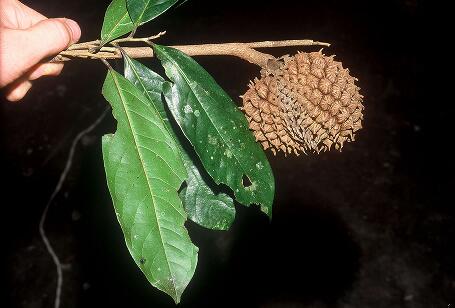Family: Annonaceae

Kingdom: Plantae Rank: Family Parent: Magnoliales Status: Valid
Common Names:
- Custard-Apple Family - English, United States of America
Taxonomic Classification
Classification: Annonaceae is in the Magnoliidae.
Morphological Description
Diagnosis: Trees with alternate leaves, etc.
Vegetative Morphology
Habit: Shrubs or small to large trees, sometimes canopy trees, rarely lianas.
Main axis: Bark strong, fibrous, easily removed in long strips, usually aromatic when cut; the slash exposing net-like vein patterns in the wood.
Leaves: Leaves alternate, distichous, simple.
Reproductive Morphology
Inflorescence: Inflorescence axillary, ramiflorous, or terminal.
Flowers: Flowers actinomorphic, bisexual or rarely unisexual, generally 3-merous; sepals 3, distinct or connate at the base or completely connate, sometimes forming a cup; petals 6, usually in two whorls, usually free, cream, white, yellow, red, or purple; stamens numerous, spirally arranged; gynoecium apocarpous, the ovaries superior, the carpels one to numerous, the stigma usually sessile; placentation basal or lateral, rarely apical, the ovules one to many.
Fruit: Fruits typically apocarpous consisting of 2 to many stipitate, indehiscent or dehiscent monocarps, or partially to completely syncarpous.
Seeds: Seeds one to many per monocarp, sometimes arillate; the endosperm ruminate.
Other
Uses: The strong bark is often used to tie and carry cargo.
Notes: Sometimes confused with the Lauraceae or Myristicaceae when sterile. However, the Annonaceae can be differentiated by strong bark that peels in long strips with the removal of a leaf or stem, and a monopodial branching pattern.